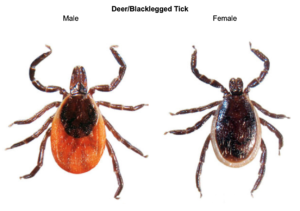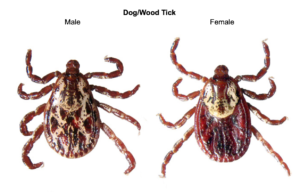Lets Talk Ticks
Ticks are actually in the arachnid family and are relatives of spiders, mites and scorpions. Ticks crawl. They do not have the capacity to jump, fly, or drop from trees. Ticks are prevalent across Canada and the most common established ticks in Canada that dogs and humans may encounter are American dog/wood tick and the deer/blacklegged tick. Please visit Tick Talk Canada for an interactive map of where these different types of ticks are most commonly found in Canada.
Ticks can be found in many areas, but they prefer to live in wooded areas, in tall grasses and under leaf litter. At 4°C ticks start looking for an animal or a person to feed on for a blood meal, and will continue until the temperature consistently remains below 4°C. That means we need to be vigilant and check for ticks from early spring to late fall.
The best way to remove a tick is to take a fine pair of tweezers, grasp the tick as close to the skin as possible, and pull up gently and firmly until the tick releases itself. Please beware, using repellents and other noxious substances in an effort to remove a tick once attached can cause the tick to regurgitate anything that it has taken as a blood meal, which increases the chance of disease transmission. Tweezers and a steady hand are your best option.


Of these commonly occurring ticks, the deer/blacklegged tick is most likely to carry Lyme Disease. In many parts of Canada, Lyme disease is an emerging infectious disease. Please learn more at Lyme disease in Canada. Visit your Doctor or Veterinarian if you think you have been exposed.
The most common symptom in a dog exposed to Lyme disease is sudden, acute lameness that may shift from leg to leg and lethargy. There may also be mild joint swelling, reluctance to eat, and a low-grade fever. These signs can show up two to five months after a tick has fed on a pet.
The most common signs of Lyme disease in humans are fever, headache, extreme tiredness, joint stiffness, muscle aches and pains and swollen lymph nodes. 
Prevention
The easiest way to start is to know where to expect ticks. Ticks live in grassy, brushy, or wooded areas. Spending time outside walking your dog, camping, or gardening can bring you in close contact with ticks. You can avoid contact with ticks by avoiding wooded and brushy areas with high grass and leaf litter and walking you and your dog in the centre of the trail when out in a wooded area.
For your dogs, you can use reliable tick-preventive products, oral or topical throughout the year. Speak with your veterinarian about what tick preventive product is right for your pet. Also, speak with your veterinarian to decide whether to vaccinate your dog against Lyme disease. Your veterinarian’s advice may depend on where you live, your pet’s lifestyle and overall health, and other factors. When possible, avoid areas where ticks might be found and check for ticks on both yourself and your animals once indoors.
For humans, the best ways to avoid tick bites are to use insect repellent on exposed skin; avoid high-risk areas, and wear protective clothing with long sleeves and long trousers tucked into socks or boots and check for ticks on both yourself and your animals once indoors.





